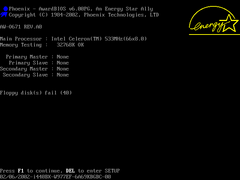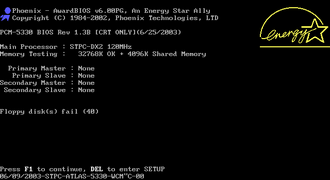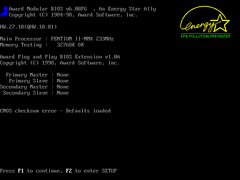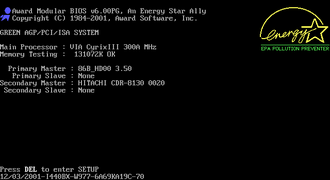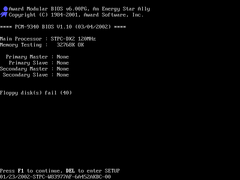No edit summary |
No edit summary |
||
| (3 intermediate revisions by the same user not shown) | |||
| Line 1: | Line 1: | ||
[[File:AwardBIOS_ModulStar6_00.png|thumb|The POST screen of AwardBIOS v6.00PG | {{IncompletePage}}[[File:AwardBIOS_ModulStar6_00.png|thumb|The POST screen of AwardBIOS v6.00PG as seen on the Biostar M7VKH motherboard]] | ||
'''AwardBIOS v6.00PG''' (codenamed ''Medallion''), also known as '''Award Modular BIOS v6.00PG,''' '''Phoenix - AwardBIOS v6.00PG''' or | '''AwardBIOS v6.00PG''' (codenamed ''Medallion''), also known as '''Award Modular BIOS v6.00PG,''' '''Phoenix - AwardBIOS v6.00PG''' or '''Award Medallion BIOS v6.00PG''', is the last version of [[AwardBIOS]]. It was first released by [[Award Software]] in April 1998 and later developed by [[Phoenix Technologies]], both of which merged around that time. It was officially discontinued on June 30, 2009.<ref>https://web.archive.org/web/20100102014331/http://phoenix.com/NR/rdonlyres/41C4EE68-A650-4969-805D-08F8798DF108/0/EOMletter_Award.pdf</ref> | ||
It is the successor of both [[Award EliteBIOS|EliteBIOS]] (mainly for consumer systems) and [[Award PowerBIOS|PowerBIOS]] (for embedded/industrial systems). | |||
== POST screen == | == POST screen == | ||
AwardBIOS v6.00PG's POST screen is mostly similar to the one used within later instances of its predecessor EliteBIOS, although there are some small differences, specifically in the memory testing and processor/storage detection sections. | |||
Between different instances of v6.00PG, the screen looks mostly similar, although some visual elements can differ depending on the vendor. Most notable of these elements are listed below. | |||
=== Screen resolution === | === Screen resolution === | ||
The POST screen can be displayed in either 640x480 or 640x350 resolution, with an 8x16 font for both modes, although most instances use the former mode. This is most likely a configuration option that was offered to vendors before compiling the ROM for a specific instance. | |||
Unlike | Unlike EliteBIOS, the 720x400 resolution mode (with 9x16 font) is not used. On EliteBIOS, this mode was commonly used for displaying the POST screen when [[silent boot]] or [[PhoenixNet]] is enabled (either for occurring errors or when manually switching from the full screen vendor logo by pressing the Tab key). | ||
=== Energy Star certification symbol (EPA) === | === Energy Star certification symbol (EPA) === | ||
Similarly to EliteBIOS, v6.00PG | Similarly to EliteBIOS, most instances of v6.00PG display an [[Energy Star|EPA]] in the POST screen, and likewise it can be modified for displaying other graphics (usually the vendor logo) instead. Aside from this, some later instances also offer a Setup setting that can disable or enable the EPA. This setting was (at least officially) never present in EliteBIOS. | ||
Early instances (usually from around 1998-1999) use the same EPA from EliteBIOS, which consists of a yellow Energy Star logo with a green line and an "EPA POLLUTION PREVENTER" text below. In circa 1999, a new EPA was introduced, which removed the text and recolored (and also slightly resized) the line to yellow, matching the logo's color. However, despite this, some vendors occasionally used the old EPA well into the 2000s. | |||
=== Version and copyright strings === | |||
Excluding the Gigabyte code fork, both the version and copyright strings were changed in later instances to mention Phoenix Technologies, which became the surviving corporate entity following the Award merge in 1998. Although this change didn't occur until 2001, as Award Software legally continued existing as an entity until then. Aside from this, the version string was occasionally also changed for other reasons, such as on some evaluation (pre-release) versions. | |||
Both of these string are displayed in the POST screen on the top left corner (usually right next to the EPA). The following variants are known for each. | |||
==== Version string ==== | |||
===== Award Software era (1998 - 2001) ===== | |||
* Award Modular BIOS v6.00PG (also used by newer instances of the Gigabyte fork after 2001) | |||
* Award Medallion BIOS v6.0 (used by the ASUS fork, possibly also used on internal evaluation versions which the fork is likely based on) | |||
* Award Medallion BIOS v6.00PG (extremely rare, likely used on newer pre-release versions) | |||
=== | ===== Phoenix Technologies era (2001 - 2009) ===== | ||
* Phoenix - AwardBIOS v6.00PG | |||
* Phoenix-Award BIOS v6.00PG (uncommon, although occasionally used) | |||
===== WorkstationBIOS (2001 - 2009) ===== | |||
WorkstationBIOS is a variant of AwardBIOS v6.00PG that was introduced in around 2001, after Award Software was officially dissolved. Although it was likely advertised as a workstation oriented special version, there are no known differences between it and regular instances. The following version strings are known for being used on WorkstationBIOS: | |||
* Phoenix - Award WorkstationBIOS v6.00PG | * Phoenix - Award WorkstationBIOS v6.00PG | ||
* Phoenix - Award WorkstationB v6.00PG ( | * Phoenix - Award WorkstationB v6.00PG (occasionally seen, possibly an improper rebrand of the regular version. The incomplete name may be a result of lack of available characters in the string while rebranding) | ||
==== Copyright string ==== | |||
* | * Copyright (C) 1984-xxxx, Award Software, Inc. (1998 - 2001, also used by newer instances of the Gigabyte fork) | ||
* | * Copyright (C) 1984-xxxx, Phoenix Technologies, Ltd. (2001 - 2009) | ||
<gallery mode="packed"> | <gallery mode="packed"> | ||
File:AwardBIOS ModulStar6 00.png|New EPA, Award copyright, VGA resolution | File:AwardBIOS ModulStar6 00.png|New EPA, Award copyright, VGA resolution | ||
Latest revision as of 16:19, 19 October 2025
This page is currently in the writing phase and is therefore incomplete, missing various details that are planned to be added.
We apologize for the inconvenience and appreciate your patience in the meanwhile.

AwardBIOS v6.00PG (codenamed Medallion), also known as Award Modular BIOS v6.00PG, Phoenix - AwardBIOS v6.00PG or Award Medallion BIOS v6.00PG, is the last version of AwardBIOS. It was first released by Award Software in April 1998 and later developed by Phoenix Technologies, both of which merged around that time. It was officially discontinued on June 30, 2009.[1]
It is the successor of both EliteBIOS (mainly for consumer systems) and PowerBIOS (for embedded/industrial systems).
POST screen
AwardBIOS v6.00PG's POST screen is mostly similar to the one used within later instances of its predecessor EliteBIOS, although there are some small differences, specifically in the memory testing and processor/storage detection sections.
Between different instances of v6.00PG, the screen looks mostly similar, although some visual elements can differ depending on the vendor. Most notable of these elements are listed below.
Screen resolution
The POST screen can be displayed in either 640x480 or 640x350 resolution, with an 8x16 font for both modes, although most instances use the former mode. This is most likely a configuration option that was offered to vendors before compiling the ROM for a specific instance.
Unlike EliteBIOS, the 720x400 resolution mode (with 9x16 font) is not used. On EliteBIOS, this mode was commonly used for displaying the POST screen when silent boot or PhoenixNet is enabled (either for occurring errors or when manually switching from the full screen vendor logo by pressing the Tab key).
Energy Star certification symbol (EPA)
Similarly to EliteBIOS, most instances of v6.00PG display an EPA in the POST screen, and likewise it can be modified for displaying other graphics (usually the vendor logo) instead. Aside from this, some later instances also offer a Setup setting that can disable or enable the EPA. This setting was (at least officially) never present in EliteBIOS.
Early instances (usually from around 1998-1999) use the same EPA from EliteBIOS, which consists of a yellow Energy Star logo with a green line and an "EPA POLLUTION PREVENTER" text below. In circa 1999, a new EPA was introduced, which removed the text and recolored (and also slightly resized) the line to yellow, matching the logo's color. However, despite this, some vendors occasionally used the old EPA well into the 2000s.
Version and copyright strings
Excluding the Gigabyte code fork, both the version and copyright strings were changed in later instances to mention Phoenix Technologies, which became the surviving corporate entity following the Award merge in 1998. Although this change didn't occur until 2001, as Award Software legally continued existing as an entity until then. Aside from this, the version string was occasionally also changed for other reasons, such as on some evaluation (pre-release) versions.
Both of these string are displayed in the POST screen on the top left corner (usually right next to the EPA). The following variants are known for each.
Version string
Award Software era (1998 - 2001)
- Award Modular BIOS v6.00PG (also used by newer instances of the Gigabyte fork after 2001)
- Award Medallion BIOS v6.0 (used by the ASUS fork, possibly also used on internal evaluation versions which the fork is likely based on)
- Award Medallion BIOS v6.00PG (extremely rare, likely used on newer pre-release versions)
Phoenix Technologies era (2001 - 2009)
- Phoenix - AwardBIOS v6.00PG
- Phoenix-Award BIOS v6.00PG (uncommon, although occasionally used)
WorkstationBIOS (2001 - 2009)
WorkstationBIOS is a variant of AwardBIOS v6.00PG that was introduced in around 2001, after Award Software was officially dissolved. Although it was likely advertised as a workstation oriented special version, there are no known differences between it and regular instances. The following version strings are known for being used on WorkstationBIOS:
- Phoenix - Award WorkstationBIOS v6.00PG
- Phoenix - Award WorkstationB v6.00PG (occasionally seen, possibly an improper rebrand of the regular version. The incomplete name may be a result of lack of available characters in the string while rebranding)
Copyright string
- Copyright (C) 1984-xxxx, Award Software, Inc. (1998 - 2001, also used by newer instances of the Gigabyte fork)
- Copyright (C) 1984-xxxx, Phoenix Technologies, Ltd. (2001 - 2009)
-
New EPA, Award copyright, VGA resolution
-
New EPA, Award copyright (with Medallion text), VGA resolution
-
New EPA, Phoenix copyright, VGA resolution
-
New EGA, Phoenix copyright, EGA resolution
-
Old EPA (EliteBIOS), Award copyright, VGA resolution
-
Old EPA (EliteBIOS), Award copyright, EGA resolution
-
No EPA, Award copyright, VGA resolution
-
No EPA, Phoenix copyright, VGA resolution
-
No EPA, Phoenix copyright, EGA resolution
Setup Utility
Unlike EliteBIOS, 6.00PG was offered with two setup utilities: An updated version of the traditional EliteBIOS setup utility with menus, and a new setup utility with tabs (instead of menus) inspired by the new PhoenixBIOS setup utility.
Traditional Setup
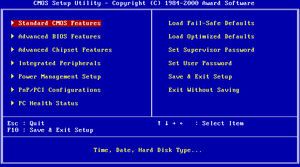
Note: This is not the official name of this setup utility.
The Traditional Setup on 6.00PG is based on the older setup utility introduced with EliteBIOS. It has the menus as before, although with a single line title (compared to the three-line title in the EliteBIOS setup) and the ability to change and view available values for each option (by pressing enter). It also now uses cyan text (hex code #00AAAA) for disabled setup options. The (Shift)F2 shortcut for changing the color set has also been removed and now only the common blue set is offered, although some Fatal1ty series motherboards from ABIT use a fully red traditional setup for 6.00PG[2]. However this is likely a modification done by ABIT and it is unlikely Phoenix ever offered different color sets for the setup.
Early instances of Traditional Setup (and the Gigabyte code fork) used the older Award Software copyright ("CMOS Setup Utility - Copyright (C) 1984-xxxx Award Software") for the title. In 2001, the copyright was removed and the title was changed to "Phoenix - AwardBIOS CMOS Setup Utility".
New/Phoenix Setup
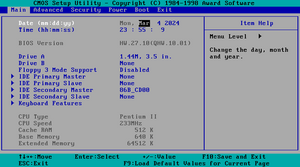
Note: This is not the official name of this setup utility.
The New Setup is based on the PhoenixBIOS 4.0x/4.0 Release 6.x setup utility. Most instances of the ASUS "Medallion" code fork also use this setup utility.
Like Traditional Setup, New Setup lacks the (Shift)F2 color set change shortcut. However unlike Traditional Setup, it was sometimes offered with different color options to manufacturers. Although the color set still can't be changed by the end user.
Code forks
ASUS "Medallion v6.0" (1999 - 2004)
In circa 1999, ASUS started releasing their motherboards with a new version of AwardBIOS called "Medallion BIOS v6.0". Unlike their previous EliteBIOS instances, this version often has new setup (based on PhoenixBIOS 4.0x/4.0 Rel 6.x setup). OEM computers (e.g. HP, Sony VAIO etc.) and some laptops with ASUS motherboards made during this era often also used this BIOS.
This version is most likely based on an internal pre-release version (beta) of AwardBIOS v6.00PG as it shares many similarities with both v6.00PG and the old EliteBIOS. Main differences between this fork and regular v6.00PG include:
- The POST screen is displayed in EGA (640x350) resolution, which is common on EliteBIOS, instead of VGA (640x480, like on most regular instances of v6.00PG).
- The older EliteBIOS EPA is used in POST, instead of the new EPA introduced in circa 1999.
- The POST screen messages resemble the ones used in EliteBIOS more than the new ones used in v6.00PG. Examples include:
- The CPU detection section does not start with a
Main Processor :text and instead only shows the detected processor, like on EliteBIOS and unlike on v6.00PG (which has the beginning text). - The Plug and Play BIOS Extension plugin shows detected PnP devices (if installed) like on EliteBIOS, unlike the new plugin on v6.00PG which only shows the copyright for the plugin instead.
- The CPU detection section does not start with a
- The setup utility is a special version of New Setup, displayed with 9x16 font and (often) with "AwardBIOS Setup Utility" text on top with no copyright copyright, unlike retail New Setup which is displayed with 8x16 and has a copyright text on top. The names of some of the options are also different from the defaults in v6.00PG New Setup. It is suspected the setup utility is based on an early pre-release instance of New Setup (just like the main BIOS itself) with more similarities with the PhoenixBIOS 4.0 Release 6.x setup compared to its final release.
The first motherboard model with this fork is most likely the ASUS P3B-F (released circa July 1999), while the last model may be the ASUS P4BP-MX (released circa February 2004). In circa 2003-2004, ASUS switched to AMIBIOS 8 (for most Intel, VIA, SiS etc. chipsets) and Phoenix - AwardBIOS v6.00PG (for most NVIDIA nForce chipsets) instead.


